What Is a Technology Roadmap? Guide (2025)
Understand what a technology roadmap is, its benefits, and how to align tech initiatives with business goals.

When you’re running a young company, getting pulled in every direction can feel normal. You have customers to keep happy, teams to coordinate and features to ship. In the middle of that chaos, it’s easy to postpone planning your technical future.
But neglecting a clear tech path often leads to costly detours, re‑work and misaligned efforts. Many first‑time founders and product managers tell us they “just need to ship” and will sort out the foundations later. In our experience working with early‑stage SaaS teams, delaying strategic technology planning makes it harder to scale responsibly.
This guide will answer what is a technology roadmap and show why such a roadmap is the backbone of a thoughtful tech strategy. It’s written for founders, product managers, and design or engineering leads who want to build strong products without guessing their way forward.
What a Technology Roadmap Is?
Technology Roadmap a strategic blueprint that describes how an organisation will use technology to meet its long‑term goals. According to Atlassian, such a roadmap is a blueprint for adapting technology to your goals and identifies the vision, goals and major milestones needed for adopting new technologies. ProductPlan describes it as a broad visual summary that maps out the vision and plans for a complex technology undertaking. Instead of a laundry list of tasks, a good roadmap shows why you’re investing in certain technologies, when different initiatives will happen and how these efforts support the bigger business picture.
Modern roadmapping grew out of older practices. Traditional roadmaps were literal maps used by drivers in the early twentieth century. In 1987 Motorola introduced the “technology‑roadmap process” to plan product strategies that met market needs. Software and hardware firms soon adopted roadmapping to communicate future work and priorities. Today roadmaps exist across disciplines—product, UX and technology—but they share a core purpose: to document where you’re headed and why.
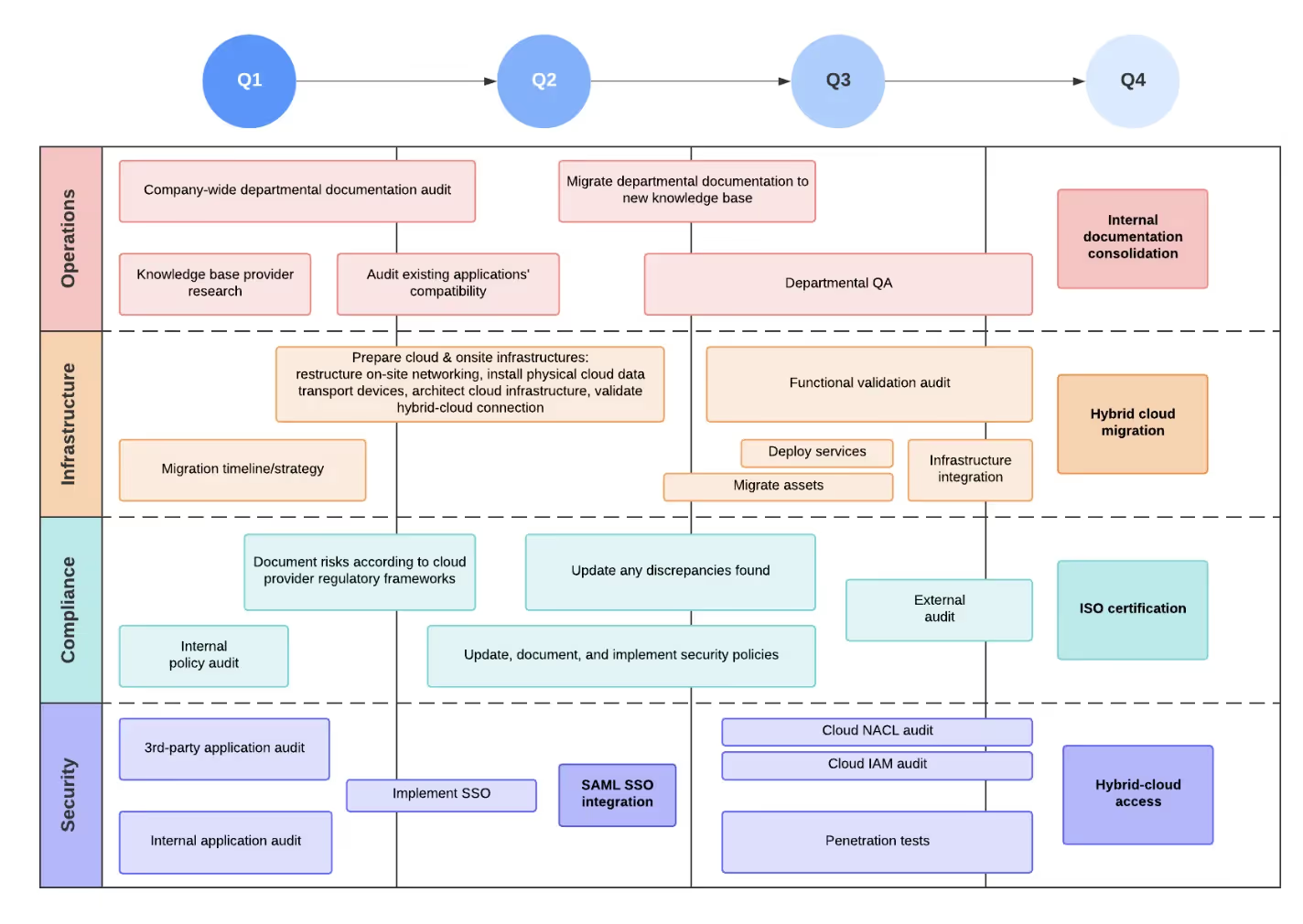
It’s useful to clarify what a technology roadmap is not. It differs from a product roadmap, which focuses on market‑facing features and customer outcomes. A product roadmap answers questions like “What problems will we solve for customers this quarter?” A technology roadmap, on the other hand, outlines the systems, infrastructure and capabilities that underpin those products. It also differs from a project plan. A project plan breaks a specific initiative into tasks, timelines and dependencies, whereas a roadmap sits above individual projects and points out how multiple initiatives contribute to a bigger vision.
Why a Technology Roadmap Matters
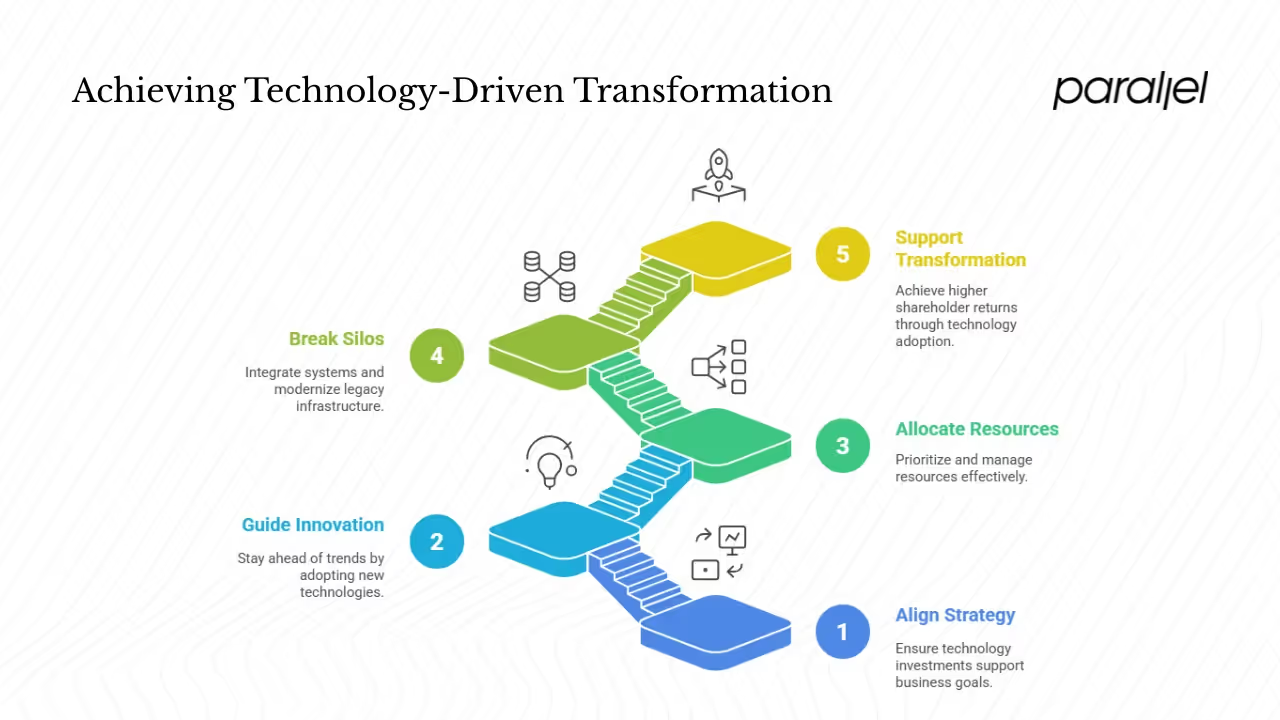
1) Matching technology and business strategy: A well‑crafted roadmap ties technical efforts to business objectives. Atlassian notes that such roadmaps ensure technology investments support the company’s strategic goals.
2) Guiding innovation and staying ahead of trends: The pace of technological change keeps accelerating. WalkMe’s 2025 review of technology‑driven transformation shows that global spending could reach nearly US$4 trillion by 2027 and that 75 % of companies plan to adopt artificial‑intelligence, cloud and data‑analytics technologies between 2023 and 2027. A roadmap helps you decide which tools to adopt and when.
3) Allocating resources wisely: A roadmap forces teams to consider people, budgets and infrastructure. Atlassian points out that clear roadmaps enable better resource allocation and project prioritisation.
4) Breaking down silos and modernising systems: Without a roadmap, teams often build point solutions that don’t work together. Roadmapping encourages integration discussions, decoupling and retiring legacy systems.
5) Supporting technology‑driven transformation: Global research shows that companies with strong capabilities in technologies such as artificial intelligence earn two to six times higher shareholder returns than laggards. A technology roadmap helps you plan upgrades and adopt new technologies methodically instead of reacting to crises.
Core Components of a Technology Roadmap
Before diving into the parts, it helps to restate what is a technology roadmap: a blueprint that connects technology to long‑term goals. While no two roadmaps look identical, effective ones share common components. Atlassian lists several important elements:
- Vision and strategic objectives: Define the problem you’re solving and how the technical work supports the company’s mission.
- Current state assessment: Audit your stack, processes and integrations. Identify strengths, weaknesses and integration pain points.
- Desired future state: Describe the future capabilities you need, such as machine‑learning models, microservices or stronger security.
- Themes or initiatives: Group related work into themes such as platform modernisation, security, performance or intelligence enablement. Themes help stakeholders see the bigger picture instead of getting lost in tasks.
- Milestones and timelines: Visual timelines show when major initiatives start and finish and reveal dependencies or bottlenecks.
- Resource allocation: Identify needed people, budget and infrastructure, including hiring plans and vendor costs.
- Risk and mitigation: List potential obstacles (e.g., vendor lock‑in, security or regulatory risks) and propose mitigations.
- Metrics and performance indicators (KPIs): Define metrics—uptime, deployment frequency, time to recovery, cost per transaction—to measure progress.
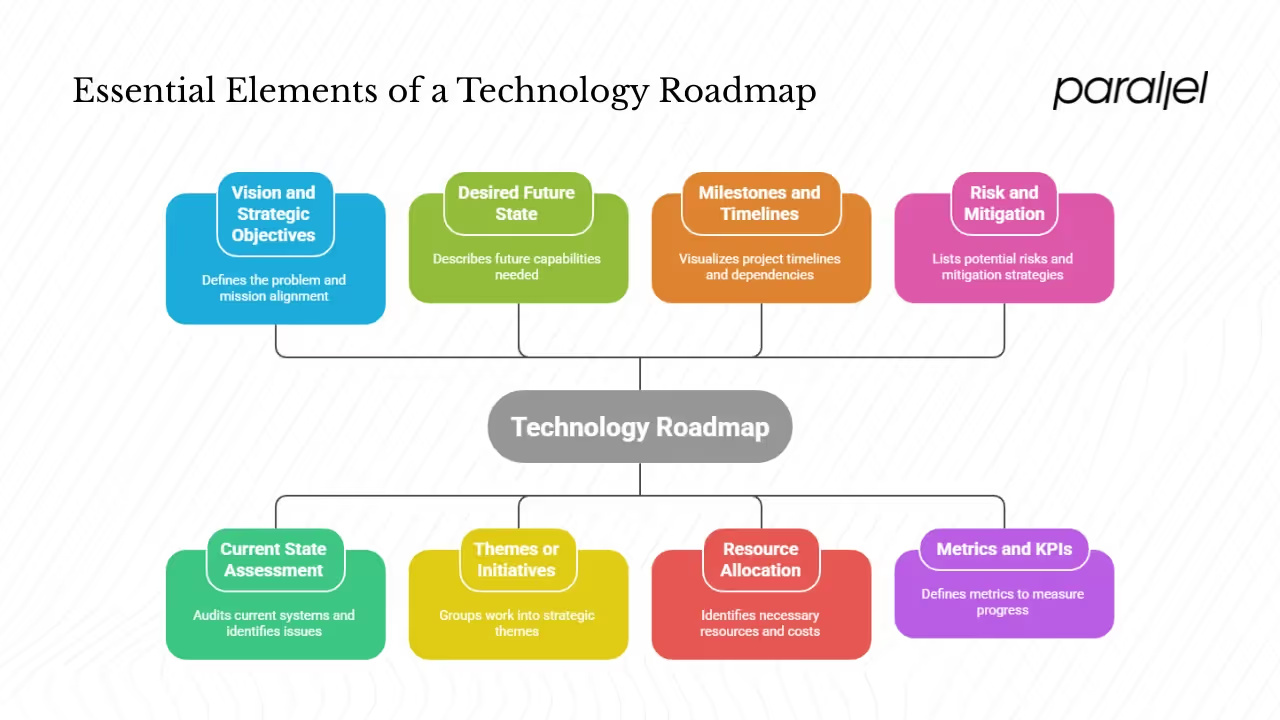
Knack’s guide adds that a roadmap should include timelines, milestones and deliverables. It also emphasises including training needs, risks, dependencies and status reporting.
Different Types and Styles
Your roadmap’s style will depend on your goals. Here are several common formats:
- Internal IT roadmap: Focuses on infrastructure improvements, system upgrades and security.
- Architecture or platform roadmap: Shows how your system’s architecture will change, covering service decoupling, database migrations, API strategies and storage improvements.
- Emerging technology roadmap: Tracks adoption of nascent technologies and identifies when experiments become production‑ready.
- Lifecycle management roadmap: Balances maintaining existing systems, phasing out obsolete components and integrating new ones.
- Implementation roadmap: Focuses on execution with tasks, timelines and deliverables for a specific initiative—useful when moving from planning to build.
How to Build a Technology Roadmap
Building a roadmap is an iterative process. The following steps synthesise guidance from Atlassian and Knack:
- Define your strategic objectives: Clarify the company’s vision and the problem the work will solve. Identify how the initiative supports growth, user experience or efficiency.
- Assess the current state: Audit your technology stack, processes and integrations. Catalogue systems and document strengths and weaknesses.
- Gather stakeholder input: Interview people across product, design, engineering and operations to understand pain points. Involving stakeholders builds ownership and ensures the roadmap meets everyone’s needs.
- Identify and prioritise initiatives: Evaluate potential initiatives by considering impact, effort, dependencies and risks. Prioritise work that supports strategic goals.
- Define timelines and structure: Group initiatives into themes or phases. Create a timeline to show when work begins and ends and make dependencies visible to avoid conflicts.
- Allocate resources and plan for risk: Plan budgets, staffing and infrastructure needs. Establish mitigation strategies for each identified risk.
- Monitor and adjust: Use dashboards or status updates to track progress and adjust priorities.
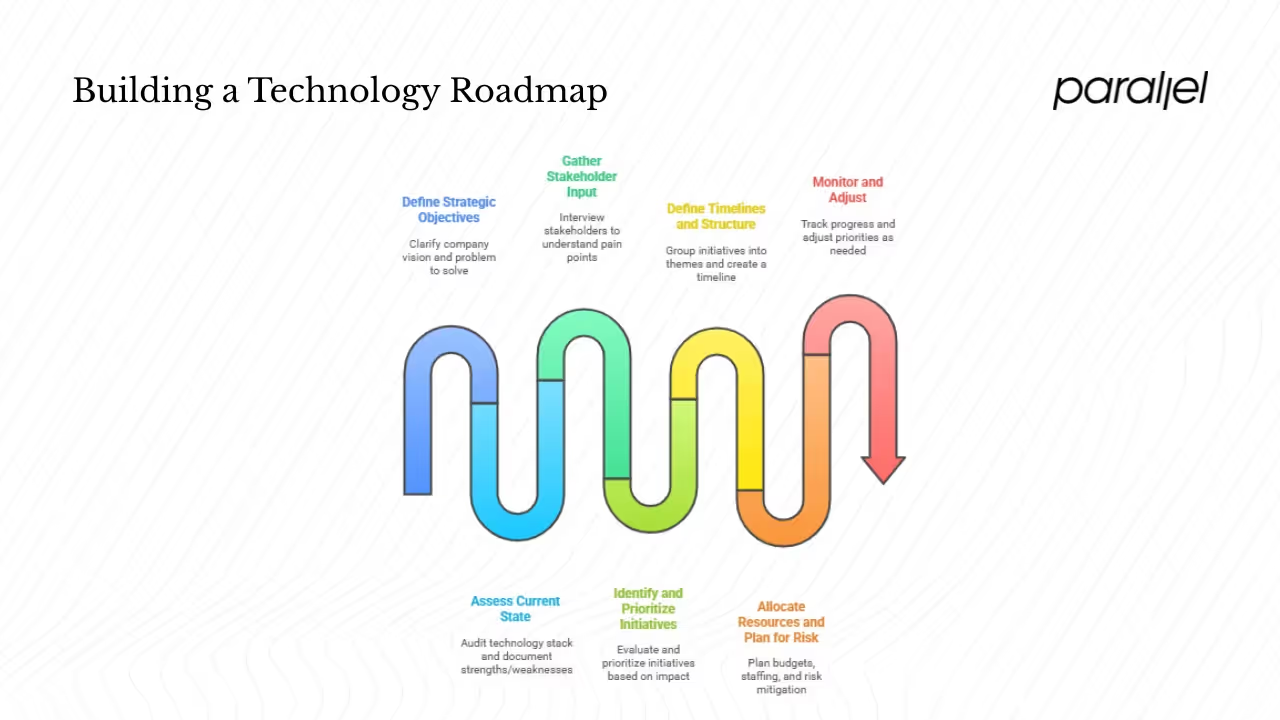
Following these steps will help you go from asking what is a technology roadmap to building one that drives your company’s technical progression.
Examples of Technology Roadmaps
Understanding the theory is helpful, but examples make it concrete. Below are simplified patterns we’ve used with clients:
- Internal IT roadmap for a SaaS startup: The team grouped initiatives into themes like stability, developer experience and security. Milestones included service migration, single sign‑on and pipeline upgrades.
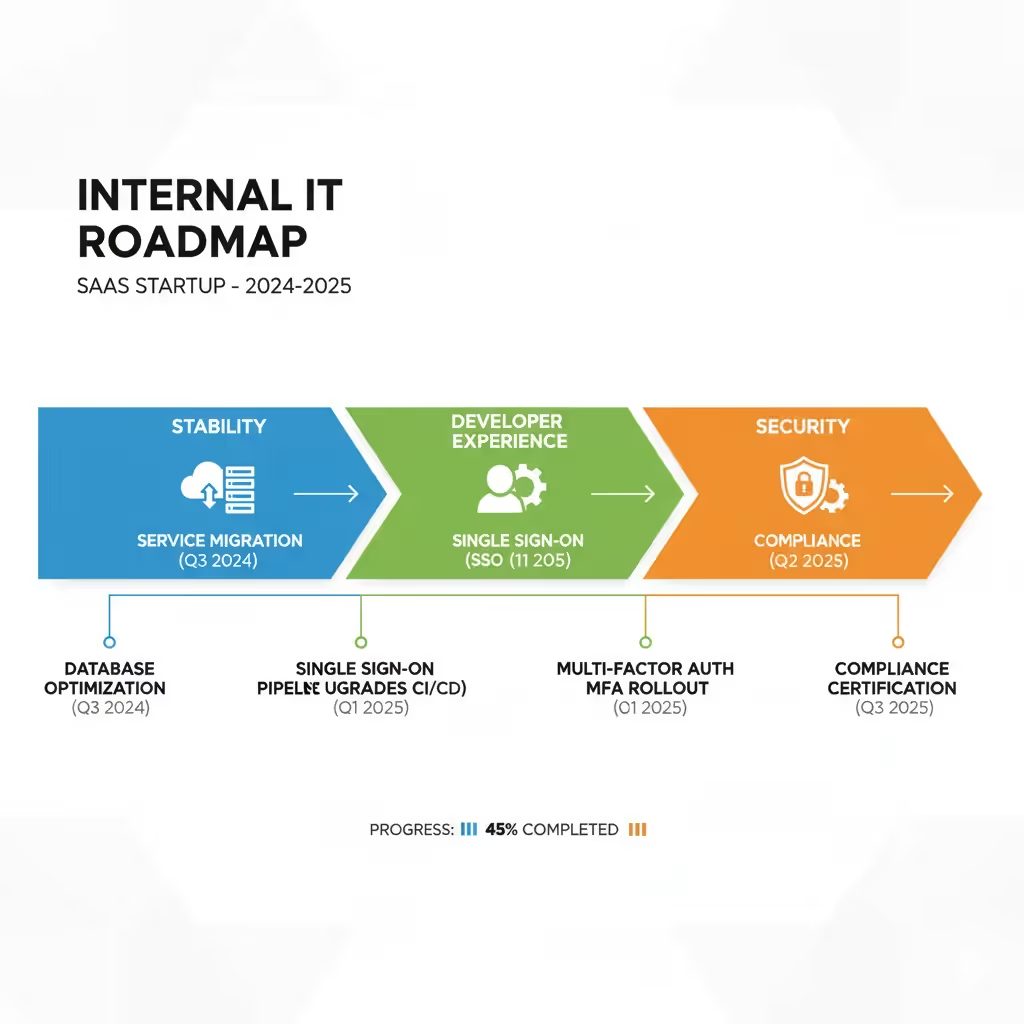
- Architecture roadmap for a consumer app: The team phased its monolith breakup: first user authentication, then the product catalogue and finally event‑driven messaging, ensuring uptime throughout.
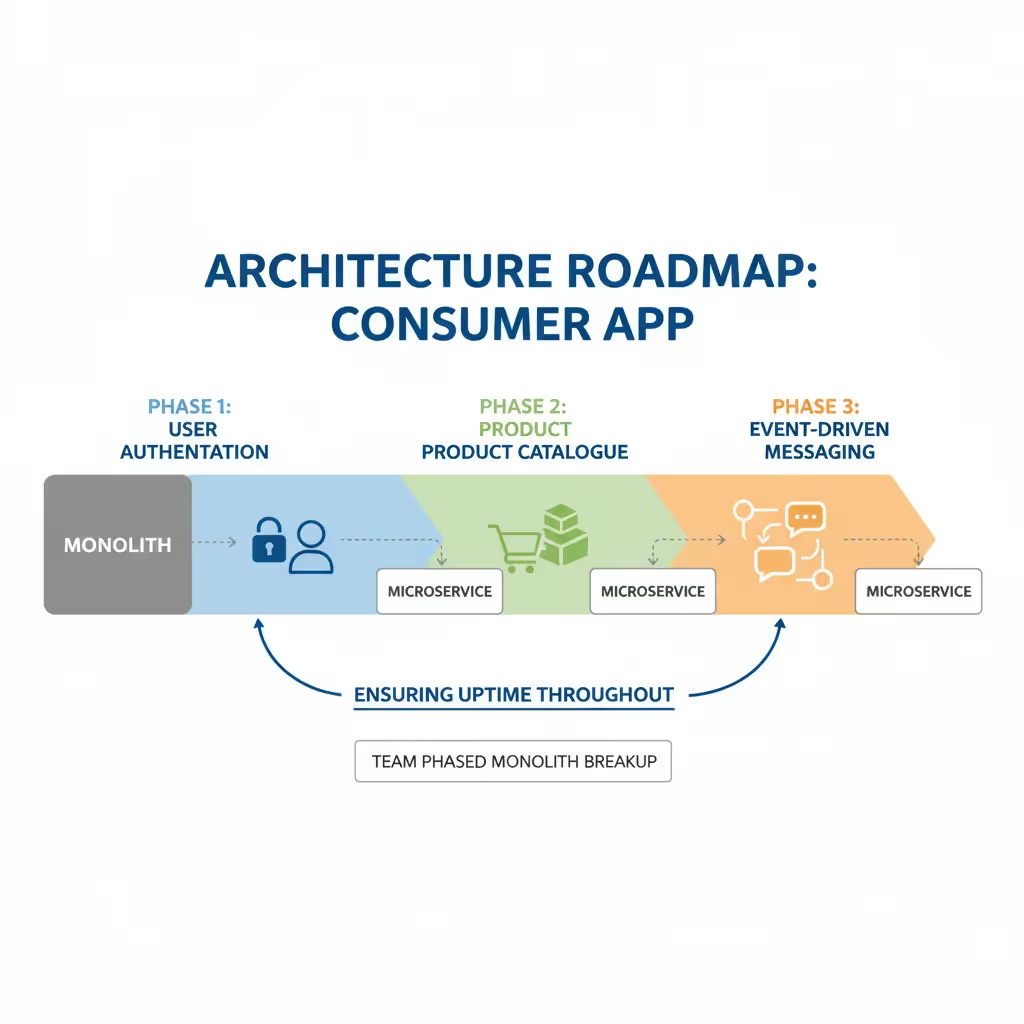
- Lifecycle management roadmap for an intelligence‑powered platform: The company balanced retiring outdated clusters, migrating models to cloud‑native platforms and introducing new models, with milestones for decommissioning, porting and training.
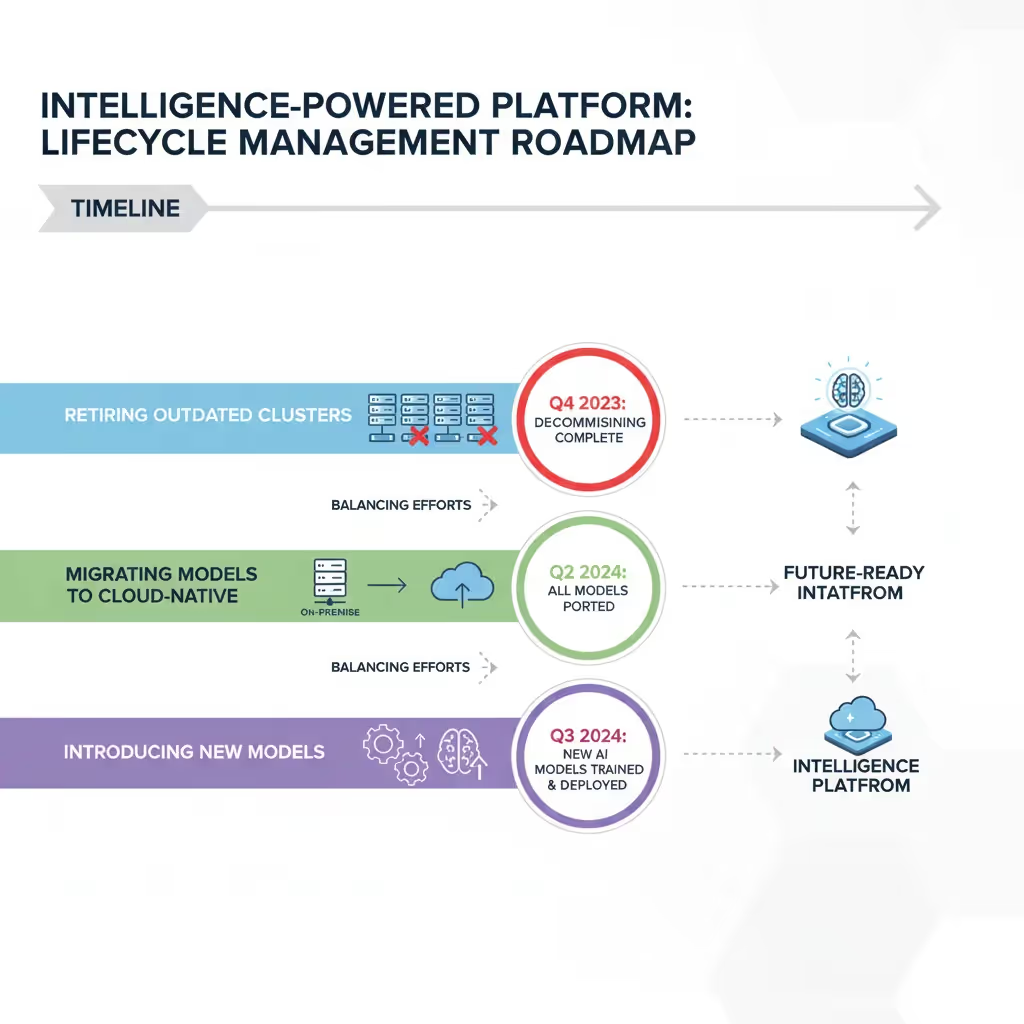
These examples illustrate that once you understand what is a technology roadmap, you can adapt the format to your context. The main thing is to stay focused on themes, milestones and how each initiative contributes to the business.
Best Practices and Pitfalls
Atlassian summarises best practices for technology roadmaps: involve cross‑functional stakeholders, support strategic objectives, focus on value, stay flexible and monitor progress. In our experience, a few additional guidelines are worth calling out:
- Work with design and product peers. Technology decisions impact customer experience. Including design leads ensures infrastructure choices support product vision and research insights.
- Keep communication simple. Use visuals and plain language when presenting the roadmap. Avoid jargon and adapt the amount of detail for different audiences.
- Invest in small wins. Roadmaps can feel daunting. Break large initiatives into incremental milestones, deliver value early and build momentum.
- Stay vigilant about change. Market conditions, regulations and technologies shift rapidly. Schedule regular reviews—quarterly at minimum—to revisit priorities.
Common pitfalls include being overly detailed (micromanaging every task), ignoring evolving technology trends, underestimating dependencies, skipping stakeholder input, neglecting metrics and failing to keep the roadmap current. A stale plan is worse than none because it breeds mistrust.
When to Create or Update Your Roadmap
Draft a roadmap when growth accelerates, technical debt mounts or pressure to adopt new technology increases. Frequent firefighting or uncoordinated tool purchases also signal the need. Update the roadmap at least semi‑annually and after major business shifts like funding rounds, new markets or regulation changes.
How to Roll Out a Roadmap Internally
Adapt your roadmap presentation to founders, engineers, designers and operations. Executives care about business impact, while engineers need more detail about architecture, dependencies and resources. Consider multiple views of the same roadmap customised for each audience. Use simple visuals and dashboards to distinguish themes and track progress.
Embed the roadmap into planning rituals. Review it, encourage feedback and adjust priorities when new information comes up. A roadmap is a living guide; it evolves with your team’s understanding.
Conclusion
If you started this guide wondering what is a technology roadmap, you should now see it as a foundational tool that ties technical development to business direction. By now you know what is a technology roadmap and why it matters. A roadmap clarifies the long‑term vision, documents the current and future state of your systems, prioritises initiatives and helps you allocate resources thoughtfully. More importantly, it turns technology decisions into deliberate choices rather than reactive fixes. Start by listing your objectives, auditing your current state and asking your stakeholders where they feel the most pain. Draft a simple roadmap that shows themes and milestones. Share it widely, collect feedback and revise it regularly. Building and using a roadmap is not about predicting the future—it’s about making intentional choices together.
FAQ
1) What is meant by technology roadmap?
Think of it as a strategic plan that documents how you’ll use technology to achieve your business goals. It outlines the vision, major milestones and resources needed. Instead of focusing on individual features, it shows why certain systems and infrastructure are important and when you intend to work on them. Put another way, it answers what is a technology roadmap by connecting technical initiatives to business outcomes.
2) What is the overview of technology roadmap?
A technology roadmap provides a broad view of your vision, the current versus future state of your stack, planned initiatives and timelines. It fits into overall technology development by bridging your strategic goals with the practical steps needed to modernise systems, upgrade infrastructure and introduce new capabilities. It provides context for product roadmaps by illustrating the enabling work behind customer‑facing features.
3) What does a roadmap include?
A typical roadmap contains strategic objectives linked to business strategy, an assessment of the current stack, future capabilities you want to develop, grouped initiatives or themes, timelines and milestones, resource allocations, identified risks, and metrics or performance indicators to monitor progress. Knack’s guide reminds us to include resources and training needs, potential risks, dependencies and regular status updates.
4) What is the difference between product roadmap and technology roadmap?
A product roadmap addresses customer‑facing features and market outcomes. It answers questions such as which problems you’re solving, which segments you’ll target and when features will ship. A technology roadmap focuses on the underlying systems—databases, platforms, tooling, infrastructure and long‑term technical enablers. While the two documents are separate, they are closely connected: product goals drive technical needs, and technical capabilities influence what products you can build









.avif)



